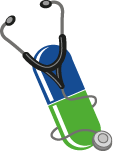Key messages for emergency departments - physicians and managers
These key messages were developed as part of a toolkit aimed at promoting prudent use of antibiotics in hospitals and other healthcare settings through dissemination of evidence-based educational and information materials.
Download

1. You are in an important position to improve antibiotic prescribing in both inpatients and outpatients, since your facility sits at the interface of the hospital and the community [77].
2. Antibiotic regimens started in your department strongly influence what therapy is continued in the hospital and community settings [77].
Tasks
3. Clinical tasks related to improving antibiotic use include [102] [expert consensus]:
a) Following local evidence-based antibiotic guidelines for common infections;
b) Deciding on the first antibiotic dose for inpatients;
c) Taking relevant cultures, before starting antibiotic therapy, which will allow antibiotic therapy to be tailored or stopped during hospitalisation;
d) Communicating all relevant patient background and treatment decisions to in- or out-patient follow-up practitioners.
e) Informing patients (and their families) about the indication for an antibiotic prescription, possible side effects, and their proper use.
4. Departmental tasks include [77] [expert consensus]:
a) Making available evidence-based hospital antibiotic guidelines and clinical pathways for diagnosing, treating and managing the most common infections encountered in your department (i.e. respiratory tract infections, skin and soft tissue infections, urinary tract infections and sepsis). This should include the indication, drug choice, dose, route of administration and duration of treatment.
b) Ensuring guidelines incorporate local microbiology and antibiotic resistance patterns, and reflect existing hospital formulary.
c) Strengthening real-time follow-up and interpretation of microbiological culture data, by coordinating with the microbiology laboratory to efficiently share results to prescribers.
d) Educating staff on infectious diseases and prudent use of antibiotics.
Things you can do
5. Follow antibiotic treatment protocols, based on evidence-based guidelines (e.g. for sepsis [74], urinary tract infections [103], skin and soft tissue infections [104]), and apply infection prevention and control measures that are established in your setting [31] [expert consensus].
6. Take a thorough patient history when you prescribe an antibiotic, including recent antibiotic use, drug allergies, use of immunosuppressive therapy, and risk factors for antibiotic resistance (for example, recent hospitalisation, recent procedure or recent travel outside of Europe) [31].
7. Remain aware of local antibiotic resistance patterns in the community, hospital and department [31] [expert consensus].
8. Only start antibiotic treatment if there is evidence of a bacterial infection, and do not treat colonisation [31,72].
9. Avoid unnecessary antibiotic prophylaxis [31,73].
10. For patients with a severe infection, initiate effective antibiotic treatment as soon as possible [31,74].
11. Ensure that cultures are taken before starting antibiotics [31,42,70,71].
12. Document the indication of antibiotic treatment, drug choice, dose, route of administration and duration of treatment in the patient chart [31,42,70,71].
13. If in doubt before you prescribe an antibiotic, you should [25,26,53,70] [expert consensus]:
- Check local, regional and national epidemiological data;
- Seek guidance and advice from a senior colleague or a member of the antibiotic stewardship team.
14. Regularly participate in training courses and in meetings that support the implementation in the hospital of: a) prudent antibiotic use, b) evidence-based, local antibiotic guidelines, and c) infection prevention and control measures [52,53].

